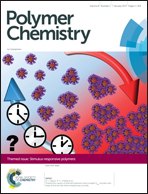RAFT polymerization to form stimuli-responsive polymers†
Abstract
Stimuli-responsive polymers adapt to their surrounding environment. These polymers are capable of responding to a variety of external stimuli, which include optical, electrical, thermal, mechanical, redox, pH, chemical, environmental and biological signals. They are encountered in many environments. They can have a variety of architectures (e.g., copolymers, blocks, stars). They may be present as isolated macromolecules in a medium, as supramolecular assemblies, as smart coatings, as networks or some combination of these possibilities. This paper is concerned with the process of forming such polymers by radical polymerization with reversible addition fragmentation chain transfer (RAFT). RAFT polymerization has an advantage over most processes for reversible deactivation radical polymerization (RDRP) in its tolerance of a wide range of unprotected functionalities. Three basic strategies for forming stimuli-responsive polymers are considered: RAFT polymerization of functional monomers (a “grafting through” approach), the post-polymerization modification of RAFT-synthesized polymers (some combination of “grafting through”, “from” and “to”), and the use of functional RAFT agents and RAFT end-group transformation (often “grafting from”). Other syntheses involve combinations of these processes and of RAFT polymerization with other processes. We also consider the responsiveness of the thiocarbonylthio-functionality of macroRAFT agents in terms of their ability to directly initiate and control RAFT polymerization and to regulate the properties of RAFT-synthesized polymers.

- This article is part of the themed collection: Stimulus-responsive polymers

 Please wait while we load your content...
Please wait while we load your content...